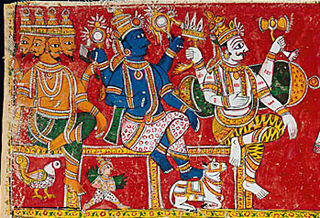热门问题
时间线
聊天
视角
三相神
来自维基百科,自由的百科全书
Remove ads
三相神(梵文:त्रिमूर्तिः trimūrti),在梵文中原意为“有三种形式”,是印度教的一个概念,“将宇宙的创造、维持和毁灭的功能分别人性化为创造者梵天,维护者或保护者毗湿奴,以及毁灭者或转化者湿婆” [1][2]。这三位神灵被认为是“印度教的三合一(the Hindu triad)”[3]或“伟大的三位一体”[4],或称为“梵天-毗湿奴-湿婆”。也有人认为这种三个神灵互相独立的理论,应该称之为三位三体论,当三个神都合为一体时,这个化身被称为Dattatreya。
- 暗质(暗性)表示无知、懒惰及灵性的黑暗,和毁灭之神湿婆有关。为黑色,对应地球上的火。
- 激质(忧性)表示活动、热情及新的开始,和梵天有关。为红色,对应地球上的土。
- 纯质(善性)表示纯净、友善及和谐,和毗湿奴有关。为白色,对应地球上的水。[5]


Remove ads
发展


在往世书时期(Puranic period,大约公元前300-1200年),后吠陀宗教和玛兹穆德所谓的“综合印度教(synthetic Hinduism)”逐渐兴起。[6]这一时期印度各宗派还没有同质化,继承古老吠陀信仰传统的正统古婆罗门教和其他在正统框架下的不同教派(知名的比如湿婆派、毗湿奴派、性力派)共存。[7]这一时期的重要特质之一就是正统派和其他宗派的和谐共存。[8]关于这种和谐共处的潮流,玛兹穆德提到:
它的最值得关注的表现可以在三相神的宗教概念中发现,比如至高神的表现形式有三种形式:梵天、毗湿奴、湿婆……但是这种尝试可能并不成功,因为梵天从没有得到超出湿婆或毗湿奴的统治地位,不同的教派常常认为三相神是自己教派的主神的三种表现形式,认为本教派的主神是梵或绝对真理。[9]
莫里斯·温特尼茨注意到印度文学中很少提到三相神。[10]《龟往世书》(Kūrma Purāṇa)十分强调梵天、毗湿奴、湿婆是同一神,而在第1.6节中梵被崇拜为三相神;第1.9节也特别反复灌输这三神的同一性;第1.26节也提到同样的主题。[11]
历史学家巴沙姆解释三相神的背景时,提到西方对三位一体的兴趣:
早期学习印度教的西方学生对与基督教类似的印度教的三位一体印象深刻。事实上这种类似并不够紧密。不像基督教的三位一体,印度教的三位一体从没有真正“流行起来(caught on)”。所有的印度教三位一体派都倾向于偏爱这三神中的某个神;因此,从这个背景来看,很明显迦梨陀娑的献给三相神的赞美诗实际上是献给被认为是至高神的梵天的。三相神实际上是人为的拔高,并没有太多的真正影响。[12]
弗里达·玛切特(Freda Matchett)描述三相神系统为“多种神的形象可以在不同的层次被组合的框架”[13]
三相神的概念在弥勒奥义书也出现过,这里三神被解释为至高神的三种首要形式。[14]
Remove ads
印度教中的观点
绍拉派(Sauram)崇拜太阳神苏利耶为至高神,下梵不接受三相神。早期的三相神形式包括先存在苏利耶而不是梵天,或者将苏利耶作为高于三相神的至高神,认为三相神是苏利耶的三种表现形式。苏利耶在早上是梵天,下午是毗湿奴,晚上是湿婆。有些绍拉派崇拜毗湿奴或湿婆为苏利耶的表现形式,另一些则膜拜三相神作为苏利耶的表现形式,还有些仅仅专门崇拜苏利耶。

毗湿奴派一般不接受三相神的概念。例如,二元论派坚持毗湿奴单独是至高神,湿婆是下属,对往世书有不同解释。二元论派学者Vijayindra Tîrtha认为毗湿奴往世书(Vaishnavite puranas)是喜往世书,湿婆往世书(Shaivite puranas)是暗往世书,仅仅喜往世书(satvic puranas)是有权威的。[15]

湿婆派根据湿婆阿含经坚持,湿婆神有五个功能——创造,保护,毁灭,隐藏恩赐(concealing grace),显露恩赐(revealing grace)。这五个功能每一个都对应湿婆的一个名字和形式。[16]

传统派(Smartism)强调五神系统,而不是一个神[17]。9世纪哲学家商羯罗使得五神系统流行。该系统崇拜五个神灵——象头神、毗湿奴、湿婆、提毗、苏利耶[18][19]。商羯罗后来又加入室建陀,称为六神。商羯罗推广这个系统同一用以联合以这六神为主要神的各大主要教派。[20]
参考文献
外部链接
参见
Wikiwand - on
Seamless Wikipedia browsing. On steroids.
Remove ads
